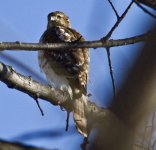Just spotted this guy in our back yard. Did not see it in flight, just sitting in the trees near the bird feeders. We're thinking Sharp Shinned Hawk based on size, about 12-14 inches from where we stood.
Any information would be greatly appreciated.
Thanks
David, Ottawa, CA
Any information would be greatly appreciated.
Thanks
David, Ottawa, CA
Attachments
Last edited:





